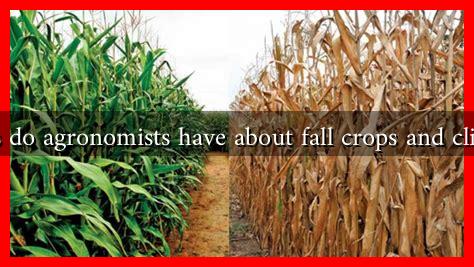-
Table of Contents
What Insights Do Agronomists Have About Fall Crops and Climate Change?
As the world grapples with the realities of climate change, agronomists are at the forefront of understanding how these shifts impact agricultural practices, particularly concerning fall crops. With changing weather patterns, increased temperatures, and unpredictable precipitation, the cultivation of fall crops is becoming increasingly complex. This article delves into the insights agronomists have gained regarding fall crops in the context of climate change, highlighting strategies for adaptation and resilience.
The Impact of Climate Change on Fall Crops
Climate change is altering the agricultural landscape in profound ways. Agronomists have identified several key impacts on fall crops:
- Temperature Increases: Higher average temperatures can lead to accelerated growth cycles, affecting the timing of planting and harvesting.
- Altered Precipitation Patterns: Changes in rainfall can lead to droughts or excessive moisture, both of which can harm crop yields.
- Pest and Disease Pressure: Warmer temperatures can expand the range of pests and diseases, posing new challenges for fall crop management.
For instance, a study by the Nature Climate Change journal found that certain regions may experience a 20% reduction in yields for staple crops like corn and soybeans due to climate-related stressors by 2050.
Adaptation Strategies for Fall Crops
Agronomists are actively researching and implementing various strategies to help farmers adapt to these changes. Some of the most promising approaches include:
- Crop Rotation: Diversifying crops can improve soil health and reduce pest pressures. For example, rotating fall crops with legumes can enhance nitrogen levels in the soil.
- Cover Cropping: Planting cover crops during the off-season can prevent soil erosion, improve soil structure, and retain moisture.
- Precision Agriculture: Utilizing technology to monitor soil moisture and nutrient levels allows for more efficient resource use, reducing waste and enhancing crop resilience.
Case studies from regions like the Midwest United States show that farmers who adopted cover cropping and crop rotation practices reported improved yields and reduced input costs, demonstrating the effectiveness of these strategies.
Research and Development in Fall Crop Varieties
Another critical area of focus for agronomists is the development of fall crop varieties that are more resilient to climate change. This includes:
- Drought-Resistant Varieties: Breeding crops that can withstand periods of low water availability is essential. For example, drought-tolerant corn hybrids have been developed that can maintain yields under water-limited conditions.
- Heat-Tolerant Varieties: As temperatures rise, heat-tolerant varieties of crops like soybeans and wheat are being researched to ensure they can thrive in warmer climates.
- Pest-Resistant Varieties: Genetic modifications and traditional breeding techniques are being used to create crops that are less susceptible to pests and diseases.
According to the USDA Agricultural Research Service, the development of these varieties is crucial for maintaining food security in the face of climate change.
Conclusion: The Path Forward for Fall Crops
As climate change continues to pose challenges to agriculture, agronomists play a vital role in developing strategies and solutions for fall crops. By understanding the impacts of climate change and implementing adaptive practices, farmers can enhance their resilience and ensure sustainable production. The integration of innovative research, technology, and traditional agricultural practices will be essential in navigating the complexities of a changing climate.
In summary, the insights from agronomists highlight the importance of adaptation in agriculture. With proactive measures such as crop rotation, cover cropping, and the development of resilient crop varieties, the agricultural sector can better withstand the challenges posed by climate change, ensuring food security for future generations.

